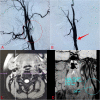Cervical artery dissection-an easily neglected cause of stroke: a case report
- PMID: 33238916
- PMCID: PMC7687846
- DOI: 10.1186/s12883-020-02006-6
Cervical artery dissection-an easily neglected cause of stroke: a case report
Abstract
Background: In recent years, the incidence of stroke has gradually increased in young people. There are many reasons causing stroke, including atherosclerosis, artery embolization, and cervical artery dissection and so on. However, cervical artery dissection is a major cause of stroke in young people. We present a case of ischemic stroke caused by dissection, whose distal vascular occlusion due to detachment of the thrombosis in the right internal carotid artery.
Case presentation: A 33-year-old male patient was admitted to the hospital because of stroke. Imaging examination showed that there was no visualization of the right middle cerebral artery and there were a large number of mural thrombus in the C1 segment of the right internal carotid artery. After emergency surgery, the patient had vascular recanalization and the symptoms were significantly improved. Magnetic resonance imaging showed a high signal in the C1 segment of the right internal carotid artery, the abnormal signal disappeared after antiplatelet therapy.
Conclusions: When a patient has symptoms of stroke, we need to explore the root cause of stroke. Especially in young people, cervical artery dissection is an important reason that can't be ignored. Through review and analysis of this case, we hope to improve the understanding of radiologists and clinicians about the cervical artery dissection, reduce the rate of misdiagnosis, and improve patients' prognosis.
Keywords: 3D-T1 VISTA; Cervical artery dissection; Stroke; VW-MRI.
Conflict of interest statement
The authors declare that they have no competing interests.
Figures


References
-
- Robertson JJ, Joyfman A. Cervical artery dissections: a review. Clin Rev Emerg Med. 2016;51:508–518. - PubMed
Publication types
MeSH terms
LinkOut - more resources
Full Text Sources
Medical
Research Materials

